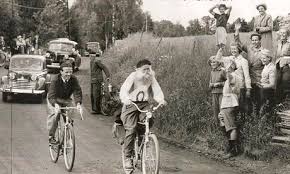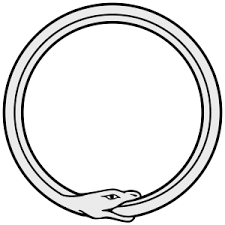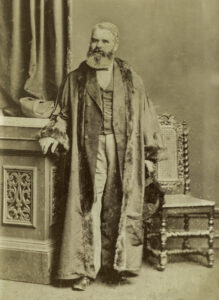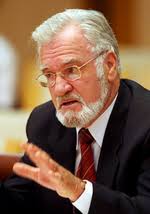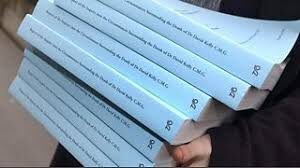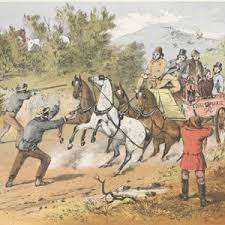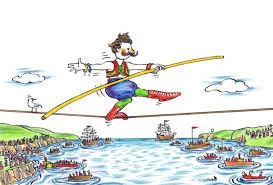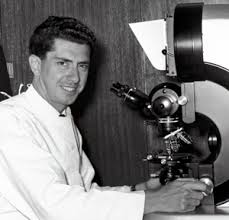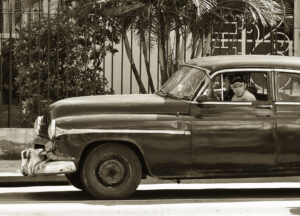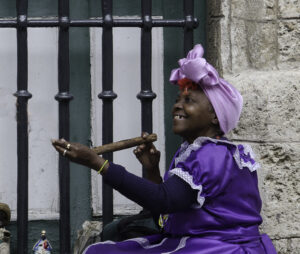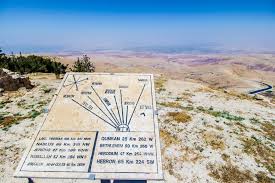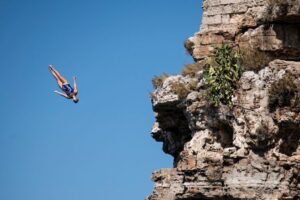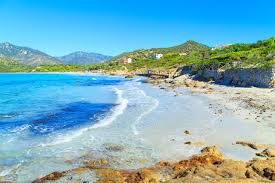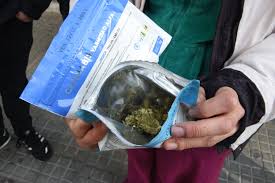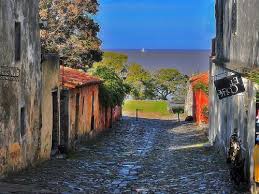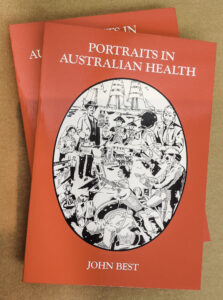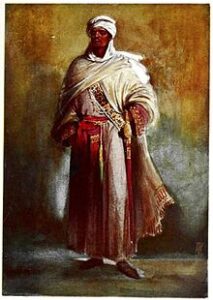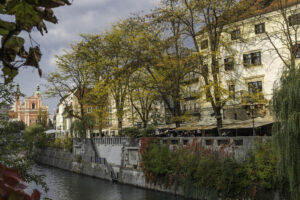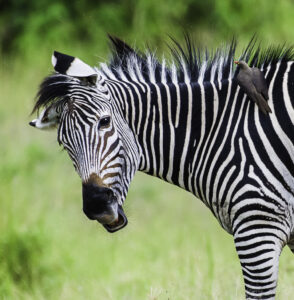Given that our prime Minister loves to immerse himself in a biblical toga, this quote from the first book of Joel, which is incidentally the 29th book in the Old Testament and thus reflects the fact that this is my 29th blog that had its genesis 29 weeks ago, seems appropriate.
The vine is dried up, and the fig tree languisheth; the pomegranate tree, the palm tree also, and the apple tree, even all the trees of the field, are withered: because joy is withered away from the sons of men.
The problem is that the drought conditions have not affected Australia equally. In fact if you look at the agricultural forecast, the crops in Victoria, South Australia and West Australia seem to be doing nicely thank you very much. There is a small caveat on there being spring rains.
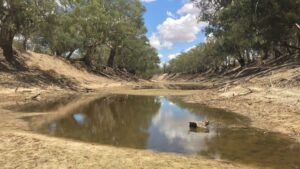
Where Australia is in drought is in NSW and Queensland where the Murray-Darling basin has been wrecked and where the National Party holds most of the electorates lining the river.
The cotton industry has been particularly greedy when it comes to use of water, but the cowboys who have played around with the water rights have not helped, and there has been one disaster piled upon another as the rivers have dried up.
I, as an Australian, have been appalled by revelations about the Basin, but then what would I know? I am just a city dweller sitting on the coastline of Australia looking out on the Parramatta River. Nevertheless, like the rest of us I am inflicted with the fatuous comments of our politicians in relation to climate change.
One lesson, which does not seem to have penetrated the skulls of these politicians, is the lessons learnt from the past.
I have travelled extensively around Australia during a time when I was responsible for the rural stock take on health 20 years ago. Even then I was amazed by the extent of the open dams, which had been created to harvest water from the Darling and its tributaries. There were a few seasons when the rains came, the water flowed and everybody lost focus on the fact that this is a dry, dry land.
However, travel to South Australia and there is a line named after a very meticulous gentleman called Goyder who determined that below the line he had drawn, cropping could be undertaken with a degree of surety and above it not. Below the line the farmer can be assured of a mean of 240mm rain a year.
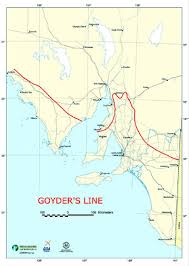
In fact testimony to the accuracy of his observations one can see the abandoned farm houses of those who did farm above the line. With climate change Goyder’s Line has been moving south and farming in South Australia has adjusted to the shift. South Australia produces 20 per cent of the country’s grain; most of it is grown without irrigation. In fact the Yorke Peninsula, where the best malting barley is grown, has no rivers at all. However, like its companion Eyre Peninsula, one can see the line metaphorically as it crosses these two areas. The farmers respect its scientific basis.
South Australia does not have any National party members elected to its bicameral legislature. South Australia is a desert state. I remember sitting on a verandah in Clare having a glass of that distinctive Clare riesling, when my host asked whether I knew I was 90 minutes from Adelaide and yet 90 minutes from Oororoo, which is above the Goyder line on the fringe of the desert. Increasingly Australia has to adjust to the degradation of the Murray-Darling Basin. Queensland and NSW will become desert states; however they await their George Goyder to show them how to cope.
David Littleproud
As the plane makes its descent, the local member scans the surrounding country, pointing enthusiastically to patches of water adjacent the many streams cutting across the verdant plain.
“It’s where the creeks have spread out,” he remarks. “It’s the best I’ve seen it in a long time.”
How things change! These words were uttered by Mr Littleproud in 2016 as he flew into his constituent town of Tambo.
Switch to last Sunday and there he was on television defending the allocation of one million dollars to the Moyne Shire for drought relief.
Now I know something about the Moyne Shire having once been a ratepayer in the Borough of Port Fairy before it was absorbed into the Moyne Shire. I also know quite a bit about the Moira Shire in Northern Victoria, having worked in Cobram, Yarrawonga , Numurkah and Nathalia for a decade.
That is where the departmental stuff up has occurred. The names have been confused. Moira Shire has been the centre of dairying in Northern Victoria along the Murray River. In this Shire Murray Goulburn dairying co-operative had a large factory complex, the travails of which I had a front row seat over a number of years.
Hence Moira Shire is a substantial dairying area together with a declining number of orchards, both industries requiring much water. Its rainfall this year is well below that of the mean rainfall.
So the simple solution for Littleproud was to admit the stuff up. But not this not very little proud “duck” – to coin a phrase. He stood on his dig and said that the northern part of the Moyne council was in drought. Consulting the map the most northerly part of the Shire is around Hexham and Woorndoo. The rainfall here is about the mean at this time of the year – 40 cm – hardly drought conditions. In any event the major dairying area is in the south of the Shire near the coast. I wonder whether the Minister has ever visited (or will visit) either Shire to assess the validity of his comment about the drought in the Moyne Shire, rather than making silly statements as he did this week.
For my part I have enjoyed a very pleasant sausage sizzle in the Minister’s town of his birth, Chinchilla, as I watched the coal train rumble by through the centre of town. We were on our way to Eromanga, so we had a view of the progressively dry microclimates along the way.
Littleproud has been a lucky man. His father was a National party Bjelke Peterson era minister and, as was the custom with the National Party, Littleproud has been the beneficiary of inheriting the increasingly arid electorate of Maranoa.
The rainfall in this part of Australia is half the average up to this point and a quarter of the rain was received on one day in March. However, how much relevance that has to a man of the country who now lives in Warwick, two hours closer to the coast than Chinchilla, I would not know.
I have read about the water scams, the gouging, the incompetence, bodgie water right transactions, the alleged criminality of stealing water from the McIntyre by Mr Cotton-Farmer-of -the-Year, John Norman, the sly allusion of his distant relationship to Littleproud’s wife, the subversion of the Culgoa River by the Sino-Japanese owned Cubbie station, not to mention the draining of the entire Darling River and its reduction to pools of algae infested toxin.
All that – but the water has gone. There is no more and of course the Coal Vandals are loose and want to pollute all the aquifers by mining sensitive areas throughout Queensland and NSW.
As I said, Littleproud has been a lucky man. He is also lucky because he followed Barnaby Joyce, who probably vies for the sash of the Champion incompetent bull politician ever.
So Littleproud could be lucky if he would be more proactive and seek remedies quickly and not be wedged by the climate change deniers.
However, Littleproud’s performance thus far does not augur well, and one may predict that Chinchilla, his hometown could soon be a mining town in a desert, as its water supply diminishes.
Thus, where is the National water policy; as usual caught up in the pass-the-parcel policy, which is translated into massive inaction.
Prayer and rain dancing is the substitute and if rain comes, then who wants the discipline of a water policy beyond “miracle wishes”?
Perhaps in the interim Mr Littleproud may like to move from Warwick to Roxby Downs to get a taste of what awaits his current policy unless rain dancing bears mean raindrops falling on his head.
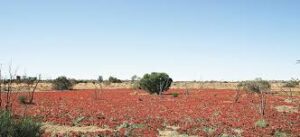
As he knows, Roxby Downs in South Australia is a major mining area producing both copper and uranium. Like Chinchilla, profitable mining. Currently this year Roxby Downs has had 4 cm of rain against a yearly average up to October of 12 cm. It requires the water to be desalinated and the population depends on the aquifers.
Spaghetti Maranoa, anybody?
A tale of two athletes
Guest Blogger: Janine Sargeant*
Wednesday the 9th was Peter Norman Day.
Dawn Fraser was suspended for 10 years (shortened to four years) for her alleged flag-stealing effort at the 1964 Olympic Games; Australia considered her a hero. Among her honours, she was Australian of the year in 1964 (the “flag” year), inducted into the International Swimming Hall of Fame in 1965, awarded an MBE in 1967, appointed an AO in 1998 and an AC in 2018; bearer of the Olympic Torch in the Sydney Olympics opening ceremony 2000. She has a swimming pool named after her – just down the road from where I am writing this.
But Dawn Fraser has lacked one thing – grace and nobility of spirit. She was rewarded for being a genuine woman larrikin, who could swim fast.
You know the true blue Aussie who is quoted as saying: “I used to do some terrible things in the marshaling area to upset my rivals.”
Compare this to Peter Norman. He ran the fastest 200 metres ever by an Australian to win a silver medal at the Olympic Games in Mexico City in 1968 – his time of 20.06 seconds still stands as the Australian record – 51 years later. But because he supported two black athletes in their support of black rights (that Carlos and Smith defined as human rights) and, as a Christian stood up for human rights, he wore a badge of the Olympic Project for Human Rights, he was shunned by the athletic establishment in Australia – that is a remarkably strong word “shunned” – it has so many overtones and undertones.
Remember the American Avery Brundage was then the Olympic head honcho – a man who had been lavish in his praise of Hitler before the 1936 Olympics in Berlin. He threw the black Carlos and Smith out of the Games.
The pervasive authoritarian right wing culture permeated Australia. Wilfrid Kent Hughes, dripping knighthoods, was still alive in 1968. He not only had identified very clearly with fascism before the War but also had run the 1956 Olympic Games in Melbourne. One can imagine in the denizens of the Melbourne Club, this “disgraceful” Norman being discussed.
Unsurprisingly, Norman was not selected for the 1972 Olympic team, despite running qualifying times. The Australian Olympic Committee to this day disputes all claims that he was ostracised – a claim made during the annual pig fly-past.
Unlike Dawn Fraser, Peter Norman had both grace and nobility of spirit. He was not a larrikin, but he ran fast.
The two black athletes he supported – John Carlos and Tommie Smith – have not forgotten him. They were pallbearers at Peter Norman’s funeral on 9 October 2006
Belatedly, long after he had receive the accolade from his black brothers, in 2012, the Australian House of Representatives passed an official apology motion recognising Peter Norman’s achievements and his bravery in wearing the Olympic Project for Human Rights badge in solidarity with Tommie Smith and John Carlos. The House apologised for the treatment Peter Norman received on his return to Australia and, belatedly, recognised the powerful role that he had played in furthering racial equality.
Peter Norman was recognised with his induction into the Sport Australia Hall of Fame in 1999 and the Athletics Australia Hall of Fame in 2010, awarded an Australian Sports Medal in 2000 and an Order of Merit from the Australian Olympic Committee in 2018 – all of this, assuaging our collective guilt.
A bronze statue honouring Peter Norman at the Albert Park athletics track in Melbourne was unveiled this week on the 13th anniversary of his funeral.
As he said to Carlos and Smith “I will stand with you.”
Now Peter Norman stands with us all.
Janine Sargeant both swam and ran … but the Olympics never beckoned. She runs a medical association in the not-for-profit sector.
An affair of the heart
Senator Bernard Sanders has had a heart attack. He has been treated but it is unclear whether he suffered any permanent damage to his heart, or whether they thrombolysed him and stented him so the muscle was not deprived of oxygenated blood so the coronary arteries could be unblocked. Almost as good as new.

Now Sanders is one sturdy post-vintage model in the automobile parlance, where running boards and crank handles are still provided. Yet would I be dependent on one such car? Perhaps on a quiet road without much traffic, and with a mechanic in the back seat.
When Bernie and I were young graduates on different continents, the treatment for a heart attack was to put you up on chocks in bed to rest, and if there were any squeaks to give you pain relief with morphine and if the engine was failing give you digoxin and if the engine was not running regularly try and correct the rhythm by drug or by electric shock.
Then came the specialised garages called coronary care units and things have become so sophisticated that the modern-day, post-vintage Bernie can leave hospital after a few days, re-bored for his next foray in winning over the American electorate.
There is a debate about “ageism” and whether it is wise to have a large number of the post-vintage vying for the most important post in the Western World. People can hark back to the fact that Eisenhower had a heart attack while President but that was near the end of his eight years and there was little resistance to Nixon taking over. The same may be said for Churchill, who was already 65 at the outbreak of World war 11 and was still puddling around as Prime Minister far beyond his use-by date in the 1950s.
So in the USA, the current situation is that all the leading contenders for the nomination are 70 years of age and above. When I reached 70 it was cited as the new 50. However, that does not mean that age has stalled – and I doubt 80 is the new 55 or 60. In any event, Trump is showing disturbing neurological signs and symptoms; Biden has been revealed as a serial plagiarist which never augurs well; Sanders has had his go last time; which leaves as a “newbie” of the 70 and over brigade, Elizabeth Warren.
I have never seen her in person, but on TV she is hard-working, articulate, intelligent, engaging, humorous – all the qualities which a misogynistic electorate will ignore at best and hate at worst.
Trump, even through the fog of impending dementia, knows he has Biden’s measure, because he will continue to bully and berate until Biden will have had enough of the abuse – this guy who frankly has little to him and certainly not the destructive firepower of Trump.
As for Bernie Sanders, he has to survive. Trump does not know how to deal with him. Crazy Bernie. Really? Pretty pathetic, Donald, you old canard.
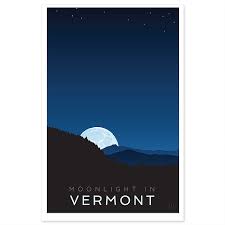
If Sanders does survive then maybe, just maybe, we will be singing Moonlight in Vermont, but somehow given the 14 month grind ahead, the Democrats will probably end up with a younger candidate.
As for Warren, the Clinton burden is considerable.
This coming year will be long year for the President and his challengers as we may expect the stress and physical demands play out on the older contenders to the Presidential crown. Maybe, beggar the thought, it could all prove too much and we could have four funerals without a wedding.
Mouse whisper
In 1977 when one of the referendum questions put to the Australian electorate was whether it would agree to a retirement age placed on all Federal judges including High Court judges of 70 years, the “yes” vote was the highest recorded in any referendum with all states voting for and over 80 per cent of the electorate over all.
As one learned source stated: It appears that in Australia, age provokes a reaction of vacation rather than reverence, and the electorate saw no reason to make an exception of High Court judges.
I like that unusual use of “vacation” – the judges were encouraged to get on their bikes when they turned 70 and to have a “vacation vacation”.
